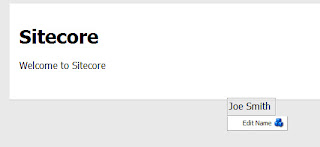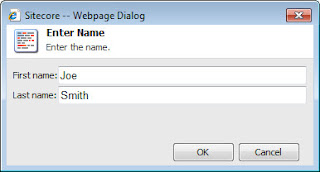TC integration module architecture
Before I get into the actual installation instructions, it's important to understand what you're going to install. I will explain each section when I get to it, but here's a quick overview:
- Authentication is handled by Sitecore using ASP.NET forms authentication.
- Sitecore is responsible for creating an authentication cookie that TC uses to provide single sign-on.
- Sitecore passes user information to TC so TC knows which roles the user has been assigned to.
- TC content is exposed to Sitecore through a REST API.
- Additions to the Sitecore client are installed using a Sitecore package.
Before you attempt to install the TC integration module version 1.1, be aware of the following:
- You must be running Sitecore 6.1 or 6.2.
- You must be running Telligent Community 5.0 SP1. Version 5.5 might work, but I haven't tested it to know for sure.
- Sitecore and Telligent Community must be running in the website or TC must be running in a domain of the Sitecore server. For example, if TC is using the domain "tc.test-server.com", then Sitecore must be using the domain "test-server.com".
- You must have read/write permissions on the folders in which Sitecore and TC are installed.
- You must have the ability to upload files to the folder in which Sitecore and TC are installed.
- You must have an administrator account on Sitecore and TC
Step 1 - Download the integration module.
The integration module can be downloaded from the Sitecore's SVN server. The easiest way to get the module is to use an SVN client for Visual Studio like AnkhSVN. You want to download the trunk code since this contains the latest bug fixes.
Step 2 (optional) - Compile the .NET assemblies.
You don't have to recompile the .NET assemblies, but I think it's a good idea because it will ensure that you are using the latest available code. Here's a description of each of the C# projects that make up the integration module so you understand what you are compiling:
- Sitecore.CommunityServerSecurityIntegration.CommunityServerSide - This assembly is deployed to the TC server. It contains code to support single sign-on as well as extensions to TC's REST API.
- Sitecore.CommunityServerSecurityIntegration.SitecoreSide - This assembly is deployed to the Sitecore server. It contains code that allows Sitecore to create the cookies that are used by TC and to migrate existing TC users into Sitecore.
- Sitecore.CommunityServersIntegration.Controls - This assembly is deployed to the Sitecore server. It is where the components that are used to access TC content are defined.
- CSComponentWizard - This assembly is deployed to the Sitecore server. It is where Sitecore client user interface additions are implemented.
Step 3 - Deploy assemblies to TC.
Copy the assembly "Sitecore.CommunityServerSecurityIntegration.CommunityServerSide.dll" to the TC server. The assembly should go in the bin folder.
Step 4 - Add a security extension in TC.
New functionality can be added to TC using extensions. A security extension allows TC to use cookies that are created by Sitecore for single sign-on.
In order to use an extension, TC must be configured to allow extensions to run. In the "communityserver.config" file in TC, set the following attribute:
- node path:/CommunityServer/Core/extensionModules
- attribute name: enabled
- attribute value: true
<name="formsauthentication" name="FormsAuthentication" extensiontype="Security" type="Sitecore.CommunityServerSecurityIntegration.CommunityServerSide.SitecoreFormsAuthentication, Sitecore.CommunityServerSecurityIntegration.CommunityServerSide" allowautouserregistration="true" userprofilecookie="CSUserProfile" useencryptedcookie="false" profilerefreshinterval="1" />
Here's a breakdown of what the attributes mean:
- name - The name of the extension you are configuring.
- extensionType - TC supports a variety of extensions. This specifies that this extension deals with security.
- type - The name of the class (and assembly) that implements the extension.
- allowAutoUserRegistration - When a user logs in from Sitecore, an authentication cookie is created. TC uses that cookie to authenticate the user. If the user doesn't already exist in TC, this setting instructs TC to create the user.
- userProfileCookie - The name of the cookie that contains user profile information about the user who has been authenticated by Sitecore. TC uses the cookie's value to set values on the TC user. Later you will configure the setting in Sitecore that sets this value.
- useEncryptedCookie -Specifies if the value saved in the userProfileCookie is encrypted. Later you will configure the setting in Sitecore that sets this value.
- profileRefreshInterval - This value specifies the frequency with which TC will refresh user information. The unit is in days, with 1 being the minimal value.
Step 5 - Enable REST API in TC.
TC provides access to its content through a REST API. This API must be enabled before Sitecore can use it.
- Log into TC using an administrator account.
- Navigate to the TC control panel and click the "Site Administration" link.
- Click the "Manage REST API" tab.
- Make sure the "Yes" option is selected and click the "Save" button.
Step 6 - Generate an application key in TC.
Sitecore uses a TC admin account in order to retrieve content. For this to work, Sitecore needs the TC admin user name and an application key.
- Log into TC using the admin account you intend to have Sitecore use.
- Edit the user's settings.
- Navigate to the "Site Options" tab.
- Scroll to the bottom of the screen and click the "Create and Edit Application Keys" link.
- In the "name" field enter "Sitecore" and click the "Generate" button.
- Write down the API key that is generated. You will need this value when you configure the connection from Sitecore to TC.
Step 7 - Modify web handlers in TC.
This integration module allows Sitecore users to filter and repurpose TC content. In order to provide Sitecore users with a variety of ways to do this, TC's REST API had to be extended.
This step involves changing the web handlers that process the REST calls. These web handlers can be found in the api\ folder under TC. The following files need to be modified. The class name in each file needs to be changed to the value following the file name:
- groups.ashx: CommunityServer.WebServices.Services.CSIGroupsService
- mediagallery.ashx: CommunityServer.WebServices.Services.CSIMediaGalleriesService
- membership.ashx: CommunityServer.WebServices.Services.CSIMembershipService
- search.ashx: CommunityServer.WebServices.Services.CSISearchService
Step 8 - Install the integration module deployment package in Sitecore.
The deployment package is available in the file named "TCSC Integration - Sitecore side-1.1.x.zip". Install this package using the Sitecore Installation Wizard.
The package includes a number of Sitecore items and files that are copied to the filesystem. Some of those files are .NET assemblies. If you recompiled the assemblies earlier, you will want to copy those assemblies into the bin\ folder in Sitecore.
Step 9 - Add a connection string in Sitecore.
Since TC is an external system that Sitecore is connecting to, an entry for TC must be added to Sitecore's connectionstring.config file. Add the following to the configuration file:
<add name="tc" connectionstring="siteUrl=http://your-server.com/tc;username=admin;apiKey=c00y45fd" />
Of course, the specific values you enter here will be different than the ones above. Here's an explanation of the values in the connectionString attribute:
- siteUrl - The base URL to your TC server. If you enter the URL in a browser you should be taken to the TC homepage.
- username - The name of the TC administrator account that Sitecore uses to communicate with TC. This must be the same account you used earlier to generate the API key.
- apiKey - The API key value you generated earlier.
Step 10 - Modify the integration module configuration file in Sitecore.
One of the files that is created by the deployment package is the integration module configuration file. This file is located in the folder "app_config/include/". The name of the file is "CommunityServerIntegration.config".
Locate the node "/configuration/sitecore/settings". This node defines the basic settings used by the integration module. Here's a description of the settings:
- CS.ProfileCookie - Remember the "userProfileCookie" attribute in TC's "communityserver.config" file? This value must match that.
- CS.EncryptProfile - This value must match the "useEncryptedCookie" attribute value from TC's "communityserver.config" file.
- CS.ConnectionStringName - This value must match the name of the connection string you configured in Sitecore's "connectionstring.config" file.
<settings>
<setting name="CS.ProfileCookie" value="CSUserProfile" />
<setting name="CS.EncryptProfile" value="false" />
<setting name="CS.ConnectionStringName" value="tc" />
</settings>
Step 11 - Configure forms authentication settings in Sitecore.
In order for single sign-on to work, both Sitecore and TC must use forms authentication. Additionally, the forms authentication settings for both must match. Make sure the "authentication" node in Sitecore's "web.config" file matches the node in TC's "web.config" file.
The important part here is the the authentication form's name and domain match. Here's the authentication node from my installation:
<authentication mode="Forms">
<forms name=".CommunityServer" protection="All" timeout="60000" loginurl="login.aspx" slidingexpiration="true" domain=".nicam.com" />
</authentication>
The domain attribute is required if TC is running in a subdomain. The dot before the domain name is needed in order for the browser to use the same cookie when sending requests to either the domain or the subdomain.
Also - and this may be common knowledge among developers but it can't hurt to be repeated - be sure your domain has at least one dot in it already. The cookie will not be written if your domain is simply "nicam". It needs to be "nicam.com".
Step 12 - Ensure the machineKey values in Sitecore and TC match.
The "machineKey" settings is important when using forms authentication in ASP.NET. Both Sitecore and TC must have the same "machineKey" configuration.
This configuration can be found in web.config. If no "machineKey" configuration exists, it must be added. Online tools are available - like this one - to generate the required settings. After you generate the configuration, add it to web.config as the last tag before the closing "system.web" tag (</system.web>).
Step 13 (optional) - Configure role and property mappings from Sitecore to TC.
Sitecore's "CommunityServerIntegration.config" file contains 2 sections that allow Sitecore user settings to be mapped to TC user settings.
The first mapping section is "rolesCorrespondence". This section allows you to specify user roles in Sitecore but still take advantage of security in TC. Sitecore roles are mapped to TC roles.
When the authentication cookie is created, the Sitecore user's roles are checked against this setting. The names of the appropriate TC roles are set in the authentication cookie. When single sign-on happens in TC, the custom forms authentication class that TC uses reads the roles from the authentication cookie and adds those roles to the TC user.
The following is an example of role mapping:
<rolesCorrespondence>
<role communityserverrole="Employees" sitecorerole="sitecore\Author" />
<role communityserverrole="Visitors" sitecorerole="extranet\Nicam" />
</rolesCorrespondence>
The second mapping section is "mappedProfileProperties". This is where Sitecore user profile properties are mapped to TC user profile properties. These values are passed to TC through the user profile cookie.
<mappedProfileProperties>
<property communityserverproperty="PublicEmail" sitecoreproperty="Email">
<property communityserverproperty="CommonName" sitecoreproperty="FullName">
</mappedProfileProperties>
Step 14 - Enable the HTML editor for display templates
Display templates determine how content retrieved from TC by the community component is formatted. Sitecore users are able control this presentation by using a rich text editor to edit display templates.
A couple of changes to the Sitecore file "/sitecore/shell/Controls/Rich Text Editor/Default.aspx" are required:
- Change the "Inherits" attribute to "Sitecore.CommunityServerIntegration.Editors.CSRADEditor". This class extends the standard Sitecore rich text editor to support the dropdown list that allows an editor to select the specific TC content fields to display.
- At the bottom of the file, add a link to the Javascript file "/sitecore modules/Shell/CSSCIntegration/RichText Commands.js". It is important that this be the last Javascript file that the browser loads. Otherwise the code in the file may be overriden by another script.
Next steps
The integration module is installed, but there's more work to do. Since Sitecore is handling authentication and is responsible for role management, existing TC users must be migrated into Sitecore. Also, Sitecore needs to be configured to create the cookies (authentication and user profile) that TC needs in order to sign a user in. I will cover these topics in my next post.
Want to learn more?





